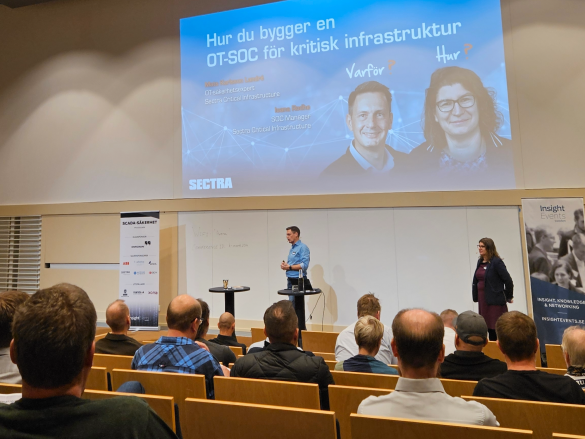“People in their own organization will always be the best at managing their systems, their processes, and their equipment. No one else can replicate that — not even we. Our role is to complement this expertise, working hand in hand with customers to strengthen defenses against cyber threats in OT systems,” said Sectra’s Mats Karlsson Landré, OT Security Expert, and Ioana Rodhe, SOC Manager, during the SCADA-Säkerhet conference.
Critical infrastructure, from energy and water systems to industrial facilities, is more connected than ever. This interconnectivity drives efficiency but also exposes operations to serious risks.
As the backbone of society, these systems must remain resilient in crises and even wartime. Protecting them demands more than maintenance; it requires real-time monitoring and proactive threat detection. That’s the role of an OT SOC, as Ioana and Mats explained during their presentation “How to build an OT SOC for critical infrastructure“.
Drawing from years of experience, they emphasized how an OT SOC enhances operational resilience by delivering real-time visibility across complex OT environments—networks often built over many years and composed of both legacy and modern systems. For instance, Sectra’s OT SOC can detect early indications of a cyber intrusion through behavior-based monitoring of assets and network traffic likely to be part of the initial stages of an attack, all the way to the system’s crown jewels or end targets. Monitoring coverage is built on threat modeling from real events and collaboration with the customer organization. This ensures detection capability before any destructive impact on critical assets or physical processes.
“It is never too early—or too late—to start monitoring your OT environment,” they stressed.
Implementing OT monitoring early allows organizations to design systems with both visibility and security built in from the start. Even when adopted later, the approach provides valuable insights, helping teams detect anomalies and act before incidents escalate. By framing monitoring as both a proactive and reactive measure, it becomes clear how essential OT visibility is for maintaining resilient and secure operations.

An OT SOC integrates seamlessly, giving teams immediate insights into complex systems. Even with legacy setups, monitoring quickly clarifies system interconnections and potential vulnerabilities.

Protecting critical infrastructure is essential to ensure that energy, water, and industrial systems continue to operate safely and without interruption.
Sectra’s OT SOC is specifically tailored to Swedish critical infrastructure and delivered by Swedish experts familiar with sector-specific operations and threat landscapes. This ensures the service goes beyond monitoring, providing guidance grounded in practical experience while complementing the internal knowledge of the organization.
Why an OT SOC matters
An OT SOC continuously monitors operational networks for abnormal activity, including unexpected shutdowns, unusual device communications, known attack patterns, and emerging threats. Unlike traditional IT systems, which manage data, business applications, and administrative tasks, OT networks directly control physical processes such as pumps, valves, conveyors, and other critical industrial equipment. Disruptions in OT systems can therefore have immediate, tangible consequences for production, safety, and service continuity.
“It’s not just about technology,” said Ioana. “An OT SOC provides organizations with a clearer understanding of their own systems. It supports informed decision-making, identifies vulnerabilities, and enables proactive responses.”
This capability is particularly critical in sectors where continuous operation is non-negotiable, including energy, water, and manufacturing.

Operational challenges
OT environments are often complex. Many organizations operate legacy equipment alongside newer technology, while external connections—such as remote access for maintenance—introduce additional risk. Historically, critical infrastructure networks were rarely designed with security in mind, making retroactive protection a careful and deliberate process.
“Organizations are often surprised by the visibility an OT SOC provides—and the ease with which we can implement it for them,” noted Mats. “Implementing a SOC on your own is feasible, but it requires significant commitment from the organization—both during implementation and in ongoing operations. And that’s where we come in.”
He added: “Organizations should focus their resources on being prepared to respond to difficult situations and to recover operations. People in their own organization will always be the best at managing their systems, their processes, and their equipment. No one else can replicate that—not even we. Our role is to complement this expertise, working hand in hand with customers to strengthen defenses against cyber threats in their OT systems.”
Implementation and benefits
An OT SOC is designed to integrate with minimal disruption. Even organizations with legacy systems can gain immediate visibility and actionable insights. The onboarding process is smooth, and customers report that monitoring quickly improves understanding of system interconnections and potential vulnerabilities.
“It’s never too early to start monitoring,” Ioana emphasized; “Early monitoring gives you increased visibility and helps drive your security efforts forward.”
“Sectra’s OT SOC is specifically tailored to Swedish critical infrastructure and delivered by Swedish experts familiar with sector-specific operations and threat landscapes. This ensures the service goes beyond monitoring, providing guidance grounded in practical experience while complementing the internal knowledge of the organization,” said Mats.

The value of an OT SOC is not just in detecting threats—it’s in helping organizations better understand their security posture within their own systems and operations. It’s never too late to start, and even if you adopt later, you still gain insights that help your organization operate more safely and efficiently.
Extending value
The benefits of an OT SOC extend beyond detection. Organizations gain structured knowledge of their networks and hidden vulnerabilities or security-relevant misconfigurations. Security considerations are incorporated into new projects, such as system upgrades or facility expansions. Centralized logging and continuous monitoring support timely and informed responses to anomalies.
In summary, an OT SOC provides a structured approach to operational security, helping organizations detect, understand, and respond to threats in real time. Early adoption supports security-driven system design, while later adoption still strengthens situational awareness and operational resilience. For operators of critical infrastructure, an OT SOC is a practical, strategic service that ensures safe, reliable, and secure operations—critical not just for business continuity but for society as a whole.
As Ioana and Mats emphasized, “The value of an OT SOC is not just in detecting threats—it’s in helping organizations better understand their security posture within their own systems and operations. It’s never too late to start, and even if you adopt later, you still gain insights that help your organization operate more safely and efficiently.”

